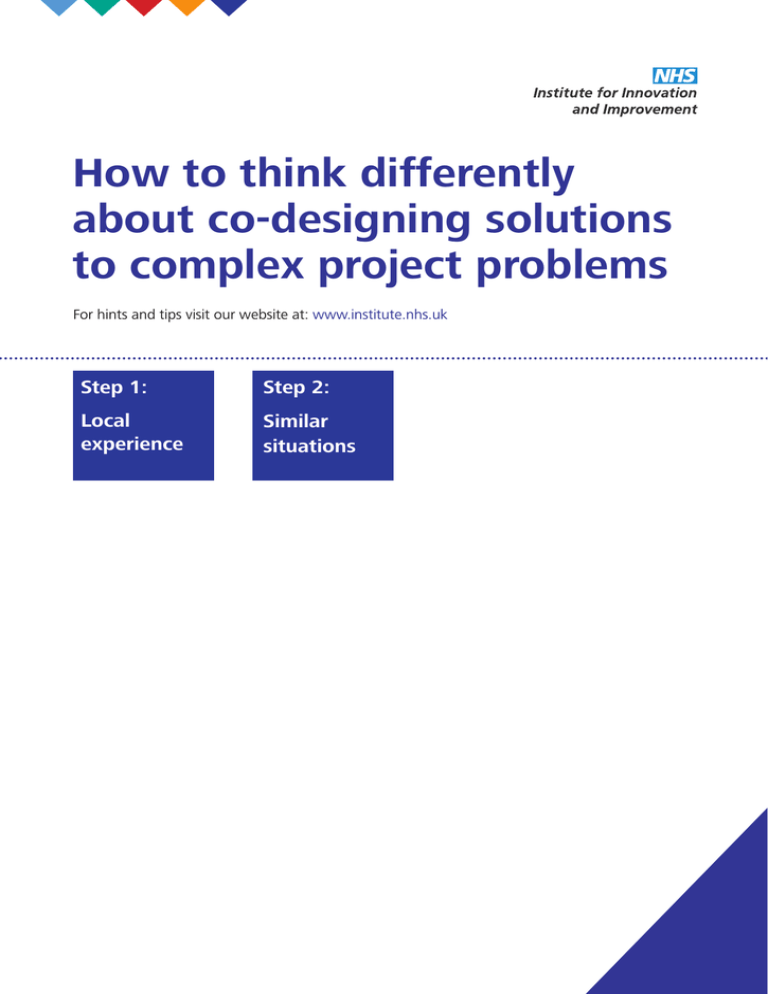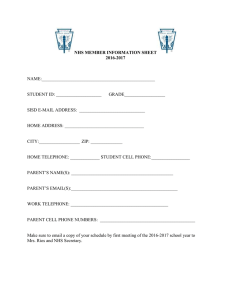How to think differently about co-designing solutions to complex care
advertisement

How to think differently about co-designing solutions to complex project problems For hints and tips visit our website at: www.institute.nhs.uk Step 1: Step 2: Local experience Similar situations The NHS Institute for Innovation and Improvement have been working with the Derbyshire End of Life project team over the last few months to look at how ‘thinking differently’ techniques can be applied to a particular issue in End of Life services. 1: Local Experience The issue is around the need to identify people who do not require resuscitation more clearly to healthcare professionals so that they do not receive inappropriate care in an inappropriate setting, particularly acute hospitals. Before pursuing the design of a potential solution, it was agreed that service users/patients would be consulted with to assess their views on this subject and clarify what would help them to have more control over their care. The NHS Institute supported this process by working to create a focus group of service users, to understand their needs and set up a way of moving forward to co-design solutions. The initial outcomes were handed over to the Derbyshire project team who will develop a larger consultation plan with other patient/service user groups and organisational stakeholders. A series of questions were developed to help to focus discussions with different audiences namely, patients, carers and staff. This template was handed over to the project team for future use in their project. Working in this way allowed the team to test their ideas before rolling them out or developing a wider consultation strategy. For further information please contact: careoutsidehospital@institute.nhs.uk 2a: Similar situations In looking at the way other international healthcare systems have addressed this problem, Derbyshire’s project team have considered the development of an identification system such as a bracelet or necklace. Comfort care bracelet In Hawaii, this system, called Comfort Care, is supported by a legislative framework and provides immediate identification of a person’s details and needs with regard to their end of life care. The discussion with the service user group was very fruitful. What is the progress so far? There was lots of discussion about the positives and negatives of an ID system such as the one in Hawaii and group members thought creatively about other potential solutions such as adapting the message in a bottle system or the medicare necklace used for medicines management purposes. The conclusion was that there are a range of ways in which needs can be identified and maybe it is better that people have a choice about which option they use rather than being given the one and only solution. Technology is not the answer as it can fail. It has to be something tangible that you can carry on your body and the user has to be in control of it and own it. The user has ultimate control of changing the identifier, no one else. Group members felt that an ID system was a positive way of regaining control which has been lost when you are diagnosed with a terminal illness. They also helped the project team by revisiting the fundamental project problem and suggesting ways forward in which they could proactively support change. They offered to work directly with the local ambulance trust and help to market a recently developed out of hours system that could be a potential focal point of support for people at end of life. This group had experience of designing an integrated information and personal records system for people with cancer which they wished to share. The design process You are invited to... Thinking differently creativity workshop Questions developed for different audiences Learning from Hawaii Working with cancer service user group (testing and prototyping) Three Top Tips 1. Involve service users and potential users of the service as early as possible in “thinking differently” about project issues. Their experiences can often lead to creative ideas as well as helpful reframing of the problem itself. 2. Use focus groups as a way of creating a positive and open environment for people to express their views and as a safe place to test ideas with people. 3. Design useful tools to give back to patient/service user groups. Prototypes
